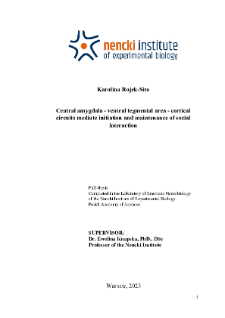
Object
Title: Central amygdala - ventral tegmental area - cortical circuits mediate initiation and maintenance of social interaction : PhD thesis
Institutional creator:
Instytut Biologii Doświadczalnej im. Marcelego Nenckiego PAN
Contributor:
Knapska, Ewelina (1977- ) : Supervisor
Publisher:
Nencki Institute of Experimental Biology PAS
Place of publishing:
Description:
148 pages : illustrations ; 30 cm ; Bibliography ; Summary in Polish
Degree grantor:
Instytut Biologii Doświadczalnej im. Marcelego Nenckiego PAN
Type of object:
Abstract:
Successful social interaction involves reciprocal contact with other individuals and requires well-orchestrated responses from interaction partners. In social species, specialized brain areas and neural networks ('social brain') mediate social interaction and allow individuals to survive and thrive. Dysfunctions of these brain networks result in decreased motivation to initiate social interaction and/or incapacity to communicate and understand social information, which causes problems with maintaining social interaction. Different mental disorders affect various aspects of social interactions. However, the neuronal circuits underlying the initiation and maintenance of social contact have yet to be discovered. As one of the primary hypotheses explaining social dysfunctions is a deficiency in reward processing, one of the promising targets to treat social impairments are neuronal circuits known to process rewards. Here, I investigated the neuronal circuit comprising the anterior cingulate cortex (ACC), orbitofrontal cortex (OFC), central amygdala (CeA), and ventral tegmental area (VTA) to verify their role in the initiation and maintenance of social interaction. Further, I tested the specificity of these circuits in social interaction by comparing their role in social interaction and food motivation. I found that the CeA cells activated by social interaction or food rewards receive projections from the ACC and OFC. Next, I discovered that chemogenetic inhibition of the ACC-CeA projection modulates the maintenance of social interaction but not the initiation of social interaction. On the other hand, inhibition of the OFC-CeA projection diminished both the social approach and the maintenance of social contact. Inhibition of either projections decreases food motivation. Further, using a c-fosdependent construct containing opsins that targets behaviorally activated neurons, I labeled the CeA cells involved in social and food reward. Optogenetic manipulations revealed that the functional overlap between these circuits is limited. To identify the CeA outputs that can be specific to social interaction, I used chemogenetic manipulations. I found that the CeA-VTA projection and the dopaminergic VTA-ACC and VTA-OFC pathways are involved in social interaction but not food motivation. Moreover, I identified the CeA-VTA and VTA-ACC projections as critical for initiating social contact and the CeA-VTA for maintaining it. Unlike most published studies, I define the circuits regulating appetitive social behaviors by their functional connectivity with other structures rather than the markers they express. Such defined neuronal circuits could serve as therapeutic targets for rescuing social deficits.
Detailed Resource Type:
Resource Identifier:
Source:
Language:
Language of abstract:
Digitizing institution:
Nencki Institute of Experimental Biology of the Polish Academy of Sciences
Original in:
Library of the Nencki Institute of Experimental Biology PAS
Projects co-financed by:
Access:
Object collections:
- Digital Repository of Scientific Institutes > Partners' collections > Nencki Institute of Experimental Biology PAS
- Digital Repository of Scientific Institutes > Partners' collections > Nencki Institute of Experimental Biology PAS > Dissertations
- Digital Repository of Scientific Institutes > Partners' collections > Nencki Institute of Experimental Biology PAS > Dissertations > PhD Thesis
- Digital Repository of Scientific Institutes > Literature
- Digital Repository of Scientific Institutes > Literature > Thesis
Last modified:
Dec 22, 2023
In our library since:
Dec 20, 2023
Number of object content downloads / hits:
46
All available object's versions:
https://rcin.org.pl/publication/276452
Show description in RDF format:
Show description in RDFa format:
Show description in OAI-PMH format:
Objects Similar
Tabaczyński, Stanisław
Byers, J. A.
MacLeod, C. D.
MacLeod, C. D.
Johnson, C. N.
Tomaszewski, Kamil Filip
Hartl, G. B. Apollonio, M. Mattioli, L.

 INSTYTUT ARCHEOLOGII I ETNOLOGII POLSKIEJ AKADEMII NAUK
INSTYTUT ARCHEOLOGII I ETNOLOGII POLSKIEJ AKADEMII NAUK
 INSTYTUT BADAŃ LITERACKICH POLSKIEJ AKADEMII NAUK
INSTYTUT BADAŃ LITERACKICH POLSKIEJ AKADEMII NAUK
 INSTYTUT BADAWCZY LEŚNICTWA
INSTYTUT BADAWCZY LEŚNICTWA
 INSTYTUT BIOLOGII DOŚWIADCZALNEJ IM. MARCELEGO NENCKIEGO POLSKIEJ AKADEMII NAUK
INSTYTUT BIOLOGII DOŚWIADCZALNEJ IM. MARCELEGO NENCKIEGO POLSKIEJ AKADEMII NAUK
 INSTYTUT BIOLOGII SSAKÓW POLSKIEJ AKADEMII NAUK
INSTYTUT BIOLOGII SSAKÓW POLSKIEJ AKADEMII NAUK
 INSTYTUT CHEMII FIZYCZNEJ PAN
INSTYTUT CHEMII FIZYCZNEJ PAN
 INSTYTUT CHEMII ORGANICZNEJ PAN
INSTYTUT CHEMII ORGANICZNEJ PAN
 INSTYTUT FILOZOFII I SOCJOLOGII PAN
INSTYTUT FILOZOFII I SOCJOLOGII PAN
 INSTYTUT GEOGRAFII I PRZESTRZENNEGO ZAGOSPODAROWANIA PAN
INSTYTUT GEOGRAFII I PRZESTRZENNEGO ZAGOSPODAROWANIA PAN
 INSTYTUT HISTORII im. TADEUSZA MANTEUFFLA POLSKIEJ AKADEMII NAUK
INSTYTUT HISTORII im. TADEUSZA MANTEUFFLA POLSKIEJ AKADEMII NAUK
 INSTYTUT JĘZYKA POLSKIEGO POLSKIEJ AKADEMII NAUK
INSTYTUT JĘZYKA POLSKIEGO POLSKIEJ AKADEMII NAUK
 INSTYTUT MATEMATYCZNY PAN
INSTYTUT MATEMATYCZNY PAN
 INSTYTUT MEDYCYNY DOŚWIADCZALNEJ I KLINICZNEJ IM.MIROSŁAWA MOSSAKOWSKIEGO POLSKIEJ AKADEMII NAUK
INSTYTUT MEDYCYNY DOŚWIADCZALNEJ I KLINICZNEJ IM.MIROSŁAWA MOSSAKOWSKIEGO POLSKIEJ AKADEMII NAUK
 INSTYTUT PODSTAWOWYCH PROBLEMÓW TECHNIKI PAN
INSTYTUT PODSTAWOWYCH PROBLEMÓW TECHNIKI PAN
 INSTYTUT SLAWISTYKI PAN
INSTYTUT SLAWISTYKI PAN
 SIEĆ BADAWCZA ŁUKASIEWICZ - INSTYTUT TECHNOLOGII MATERIAŁÓW ELEKTRONICZNYCH
SIEĆ BADAWCZA ŁUKASIEWICZ - INSTYTUT TECHNOLOGII MATERIAŁÓW ELEKTRONICZNYCH
 MUZEUM I INSTYTUT ZOOLOGII POLSKIEJ AKADEMII NAUK
MUZEUM I INSTYTUT ZOOLOGII POLSKIEJ AKADEMII NAUK
 INSTYTUT BADAŃ SYSTEMOWYCH PAN
INSTYTUT BADAŃ SYSTEMOWYCH PAN
 INSTYTUT BOTANIKI IM. WŁADYSŁAWA SZAFERA POLSKIEJ AKADEMII NAUK
INSTYTUT BOTANIKI IM. WŁADYSŁAWA SZAFERA POLSKIEJ AKADEMII NAUK


































